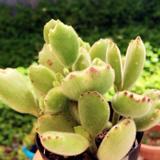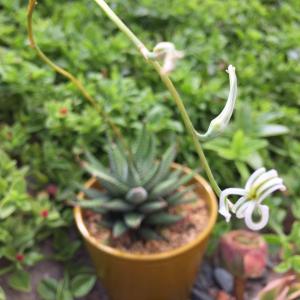文章
Dummer. ゛☀
2017年08月06日

BOTANICAL NAME: Chlorophytum Comosum
PLANT TYPE: Houseplant
SUN EXPOSURE: Part Sun
SOIL TYPE: Any
FLOWER COLOR: White
Spider Plants or Airplane Plants produce arched green and pale yellow stems that extend to be 12-18 inches long. When less than a year old, Spider Plants may produce tiny white flowers during the summer. These easy-to-grow plants look especially nice in a hanging basket.
PLANTING
Grow in soil-based potting mix in bright to moderate sunlight, but not directly facing hot sun.
Maintain average room temperature and humidity.
CARE
During growth, water occasionally; once fully developed (within one year), water moderately.
In the spring and summer months keep the soil moist. Do not let soil dry out.
Fertilize twice a month in the spring and summer, however, avoid overfertilization.
PESTS/DISEASES
Prone to tip burn from dry soil or salt and fluoride found in some public water. Keep the soil slightly moist. Avoid using fluoridated water.
To rid of the brown discs on leaves, use your fingernail to remove the brown residue every few days.
PLANT TYPE: Houseplant
SUN EXPOSURE: Part Sun
SOIL TYPE: Any
FLOWER COLOR: White
Spider Plants or Airplane Plants produce arched green and pale yellow stems that extend to be 12-18 inches long. When less than a year old, Spider Plants may produce tiny white flowers during the summer. These easy-to-grow plants look especially nice in a hanging basket.

PLANTING
Grow in soil-based potting mix in bright to moderate sunlight, but not directly facing hot sun.
Maintain average room temperature and humidity.

CARE
During growth, water occasionally; once fully developed (within one year), water moderately.
In the spring and summer months keep the soil moist. Do not let soil dry out.
Fertilize twice a month in the spring and summer, however, avoid overfertilization.

PESTS/DISEASES
Prone to tip burn from dry soil or salt and fluoride found in some public water. Keep the soil slightly moist. Avoid using fluoridated water.
To rid of the brown discs on leaves, use your fingernail to remove the brown residue every few days.
3
2
文章
Miss Chen
2017年08月05日


Description: This herbaceous perennial plant forms a rosette of spreading to ascending basal leaves. The basal leaves are up to 12" long and 4" across, although they are usually less than two-thirds of the maximum size; they are simple-pinnate with 5-11 pairs of sessile opposite leaflets and a sessile terminal leaflet. The petioles of basal leaves are relatively stout and more or less long-hairy, especially toward their bases; they are light green, whitish yellow, or red. The leaflets become gradually larger toward the tips of the compound leaves; they are up to 2" long and ¾" across. The leaflets are elliptic-oblong or oblanceolate-oblong in shape and coarsely serrated along their margins; the teeth of the margins have narrow bristly tips. The upper leaflet surface is yellowish green to dark green, glabrous to sparsely hairy, and more or less shiny. The lower leaflet surface is white-canescent from dense minute hairs, and some longer white hairs may be present. Interspersed between these leaflets, there are often much smaller secondary leaflets with similar characteristics.
The rachises of the compound leaves are similar to their petioles, except there are grooved above and tend to be less hairy. From the center of the rosette of basal leaves, one or more widely spreading stolons are produced that are 1-3' long. At intervals along these stolons, there are leafy-bracted nodes about 4-6" apart. The stolons are red, terete, and glabrous to sparsely long-hairy. The leafy bracts of the nodes are simple-pinnate; they resemble the basal leaves, except they are much smaller in size (up to 4" long and 1" across). When the nodes have contact with moist ground, they are able to develop new roots, from which new rosettes of basal leaves can develop. Solitary flowers are produced from the nodes of the stolons on long naked pedicels (floral stalks) about 2-6" long. These ascending to erect pedicels are light green to red, terete, and nearly glabrous to long-hairy. Each flower spans about ¾" across, consisting of 5 spreading yellow petals, 5 light green sepals, a ring of 20-25 yellow stamens, and a central head of 20-100+ yellow pistils. The petals are obovate or broadly elliptic in shape, while the hairy sepals are ovate, and often cuspidate (abruptly tapering into narrow pointed tips).
Directly underneath the sepals, there are 5 floral bractlets; these bractlets are similar to the sepals, except they are usually lanceolate and sometimes sparingly toothed. Both the sepals and bractlets are joined together at the base, and they are both shorter than the petals. The blooming period occurs during the summer and early autumn for 2-3 months. Flowering is more abundant during periods of active growth. Cross-pollination of the flowers is required for the production of fertile seeds. The seedheads are cupped along their sides by the persistent sepals and floral bractlets. Individual seeds are 2–2.5 mm. long, compressed-ovoid in shape, and grooved along the upper surface. Because the outer seed coat is somewhat corky from enclosed air pores, the seeds are able to float on water; they can also be blown about by the wind. The primary root system consists of a taproot that often branches. This plant forms clonal colonies by means of its stolons.
Cultivation: The preference is full sun, wet to mesic conditions, and calcareous soil containing gravel or sand. This plant doesn't tolerate much competition from taller vegetation.
Range & Habitat: The native Silverweed is uncommon in NE Illinois, while in the rest of the state it is absent (see Distribution Map). Silverweed has a wide distribution in boreal areas of North America, and it also occurs in Eurasia. Habitats include sand prairies, moist sand flats (pannes), borders of interdunal swales, low areas along sandy ponds, small sand dunes, middle to upper beach areas, and gravelly or sandy areas along mowed paths. In Illinois, this plant occurs primarily along Lake Michigan. It is usually found in high quality habitats where there is some natural disturbance from water or wind, although it can also colonize open degraded areas that are moist, sandy, or gravelly. This is one of the pioneer plant species that helps to stabilize the sand in wetlands, low dunes, and beach areas.
Faunal Associations: The flowers are usually cross-pollinated by various bees and flies, including bumblebees, cuckoo bees (Stelis spp.), Andrenid bees, and Syrphid flies (Miyanishi et al., 1991; Krombein et al., 1979; Discover Life, 2015). Both nectar and pollen are available as floral rewards. A small number of insects have been reported to feed on the foliage, sap, or roots of Silverweed in North America. These species include a flea beetle (Altica browni) and several aphids (Chaetosiphon fragaefolii, Macrosiphum potentillae, and Rhopalosiphoninus latisiphon); see Clark et al, (2004) and Blackman & Eastop (2013). Foliage and flowers of Silverweed are occasionally browsed by White-tailed Deer and other hoofed mammalian herbivores, although they are not eaten by the granivorous American Bison. By surviving the passage through their digestive tracts, the seeds of this plant may be spread to new locations by these mammals.
Photographic Location: A moist gravelly area along a path and a low area along a sandy pond at Illinois Beach State Park in NE Illinois.
Comments: A scientific synonym of Silverweed is Potentilla anserina. The description of this plant refers to the typical subspecies, Argentina anserina anserina. This is the only subspecies that occurs in Illinois. Other subspecies have been described that vary in such characteristics as the hairiness of the foliage, the general size of individual plants, the presence or absence of an upper groove on the seeds, the relative size of the sepals versus the floral bractlets, and other characteristics. It is relatively easy to distinguish Silverweed from similar species (mainly Potentilla spp.). Compared to these other species, Silverweed can be distinguished by the greater number of leaflets per compound leaf, brilliant white undersides on its leaflets, sharp bristly teeth along the margins of its leaflets, and conspicuous red stolons.

0
0
文章
Miss Chen
2017年08月05日


Description: This perennial plant consists of a tuft of basal leaves from which one or more flowering stalks emerge. The basal leaves are erect, ascending, or arching; they are up to 12" long and up to 8 mm. across. The basal leaves are linear in shape, medium green, glabrous, and smooth along their margins; they are solid and flattened. Leaf venation is parallel. Each leaf is slightly keeled along its midvein. The flowering stalks are up to 1½' long and more or less erect; they are light green or light reddish purple, glabrous, and terete. Each stalk terminates in a nodding umbel of flowers that emerges from a pair of sack-like membranes; these membranes are deciduous. Each umbel spans about 1½–2" across, consisting of 40-60 pedicellate flowers.
The flowers are individually about ¼" (6 mm.) across, consisting of 6 spreading tepals, 6 exserted stamens, and an ovary with a style. The tepals are white, light lavender, or pink; they are lanceolate in shape. The stamens have white filaments and yellow anthers. The pedicels are ½–1" long; they are light green or light reddish purple, glabrous, and more or less terete. The blooming season usually occurs during mid-summer, lasting 3-4 weeks. There is no noticeable floral scent. Afterwards, the flowers are replaced by seed capsules; each capsule contains several small black seeds that it splits open to release. The root system consists of a bulb that is longer than it is wide. Both the bulb and foliage of this plant have a typical onion-like scent. Clonal offsets are produced, forming new bulbs underground.
Cultivation: The preference is full to partial sun, moist to mesic conditions, and soil containing black loam, sand, or rocky material. While this plant can survive hot dry summers, it does better with more moisture. Foliar disease is rarely a problem. This plant is easy to grow under cultivation, and it will spread gradually under suitable conditions. It is easier to establish plants by transplanting the bulbs of offsets, rather than by attempting to germinate the seeds.
Range & Habitat: Nodding Onion is an uncommon plant that occurs only in NE Illinois (see Distribution Map), where it is native. Habitats include black soil prairies, sandy pannes, and thinly wooded bluffs. Much of the prairie habitat where this plant once occurred has been destroyed by development. Nodding Onion is normally found in high-quality natural areas, although it could escape from cultivation into more disturbed areas.
Faunal Associations: The nectar and pollen of the nodding flowers attract primarily bees, including honeybees, bumblebees, Anthophorine bees (Anthophora spp.), and Halictid bees (Lasioglossum spp.). Insects that feed destructively on the foliage, bulbs, and other parts of Nodding Onion and other onion species (Allium spp.) include the Onion Plant Bug (Lindbergocapsus allii) and a similar plant bug (Lindbergocapsus ainsliei), larvae of the False Japanese Beetle (Strigoderma arbicola), larvae of the Onion Maggot (Delia antiqua), larvae of the Black Onion fly (Tritoxa flava), larvae of the Onion Bulb Fly (Eumerus strigatus), and Onion Thrips (Thrips tabaci). Mammalian herbivores usually avoid Allium spp., although cattle and other livestock may browse on their foliage along with the grass in pastures, causing an off-flavor in their milk.
Photographic Location: The photographs were taken at the wildflower garden of the webmaster in Urbana, Illinois, and at a restored prairie in Meadowbrook Park of the same city.
Comments: This plant is easy to identify because of the nodding habit of its umbels of flowers. Nodding umbels of flowers are an evolutionary adaptation that tends to restrict insect visitors to bees. Other insects are more reluctant to hang upside down while attempting to feed on nectar or pollen. The nodding habit may also protect the nectar from rain. Compared to 2 other species that are native, the Cliff Onion (Allium stellatum) and Wild Garlic (Allium canadense), Nodding Onion (Allium cernuum) has wider leaves. Compared to the non-native Field Garlic (Allium vineale), Chives (Allium schoenoprasum), and Cultivated Onion (Allium cepa), the leaves of Nodding Onion are flattened and solid throughout, rather than hollow.

0
0
文章
Miss Chen
2017年08月05日


Description: This perennial plant consists of a rosette of basal leaves that are about 6-12" long and 2-3 mm. across. These erect to semi-erect leaves are linear, flat, and often slightly arching; they are medium green and glabrous. Each leaf has a poorly defined keel along its midvein, while its margins are smooth. Occasionally, flowering stalks emerge from the ground that are about the same height as the leaves, or slightly higher. These stalks are terete (round in cross-section), rather than flat, and they are held stiffly erect. Each stalk terminates in an inflorescence that has a sack-like covering spanning about ¾" across. This sack-like covering is white-membranous and ovoid in shape, tapering into a long beak at its apex. This covering splits open and withers away to reveal an umbel of about 6-12 pedicellate flowers or a similar number of sessile bulblets (frequently some combination of both).
The star-shaped flowers are about ½" across. Each flower has 6 tepals, 6 stamens, and a light green ovary with a style. The tepals are lanceolate to elliptic in shape and white, light pink, or pink. The bulblets are about ¼" long, ovoid in shape, and light green to pinkish red. Wild Garlic is especially likely to flower or have reddish bulblets in a sunny situation. The pedicels of the flowers are about ¾" long, medium green, glabrous, and terete. The blooming period occurs during early summer and lasts about 3-4 weeks. There is no noticeable floral scent, although the foliage exudes a typical onion scent. After the blooming period, the flowers are replaced by seed capsules; each capsule contains several small dark seeds. The root system consists of a bulb with thick fibrous roots, from which offsets may occasionally develop. This plant can also reproduce by its seeds and/or aerial bulblets.
Cultivation: The preference is full sun or partial sun, moist to mesic conditions, and a fertile loam. This plant also grows in light shade in wooded areas, but it is less likely to flower (instead, only aerial bulblets are produced). While growth is best in a fertile loam, other kinds of soil are tolerated. Periods of dry weather are also tolerated. While Wild Garlic spreads readily by means of offsets and bulblets, it often fails to produce viable seeds. This is one of the first plants to develop leaves during the spring.
Range & Habitat: Wild Garlic occurs in every county of Illinois, where it is native and quite common. Habitats include moist to mesic black soil prairies, upland and floodplain woodlands, moist meadows near rivers and woodlands, thickets, banks of streams, thinly wooded bluffs, abandoned fields, pastures, areas along railroads, roadsides, and waste areas. Wild Garlic has low fidelity to any particular habitat; it is often observed in degraded prairies and woodlands. This plant doesn't compete well against taller forbs, such as Canada Goldenrod (Solidago canadensis), preferring areas with less ground cover.
Faunal Associations: The nectar and pollen of the flowers attract the Onion Bee (Heriades carinatum), mason bees (Hoplitis spp.), Stelid bees (Stelis spp.), Halictid bees (Lasioglossum spp.), plasterer bees (Colletes spp.), masked bees (Hylaeus spp.), Syrphid flies, bee flies (Bombylius spp.), and wasps. Other insects suck plant juices, feed on bulbs, and other parts of Wild Garlic and other Allium spp. These species include the Green Stink Bug (Acrosternum hilaris), the Onion Plant Bug (Lindbergocapsus allii), larvae of the False Japanese Beetle (Strigoderma arbicola), the Onion Maggot (Delia antiqua), larvae of the Black Onion Fly (Tritoxa flava), larvae of the Onion Bulb Fly (Eumerus strigatus), and Onion Thrips (Thrips tabaci). During the early spring when little else is green, the vernal basal leaves of Wild Garlic are occasionally browsed by White-tailed Deer (personal observation). Other hoofed mammalian herbivores, such as cattle, will consume Wild Garlic along with grass and other plants. This can cause the milk of such animals to have an off-flavor. Rabbits avoid consumption of this plant because they appear to dislike the onion scent and spicy taste of the foliage. The foliage and bulbs are edible to humans, although the consumption of large amounts may be slightly toxic.
Photographic Location: The photographs were taken at Red Bison Railroad Prairie in Savoy, Illinois.
Comments: This is the most common species of native onion (Allium sp.) in Illinois. Wild Garlic (Allium canadense) can be readily distinguished from other native onions, such as the Cliff Onion (Allium stellatum) and Nodding Onion (Allium cernuum), by the presence of aerial bulblets in its inflorescence. An introduced onion in Illinois, Field Garlic (Allium vineale), also produces such bulblets. However, the leaves of Field Garlic are elliptic in cross-section with a hollow interior (at least at their bases), while Wild Garlic has leaves that are flat and solid throughout. There is a variety of the Wild Garlic (Allium canadense var. mobilense) that produces only flowers, rather than bulblets and flowers, or only bulblets. However, it is less common than the typical variety, as shown in the photographs.

0
1
文章
Miss Chen
2017年08月03日


- Nombre científico o latino: Acanthocalycium spp.
- Nombre común o vulgar: Acanthocalycium.
- Origen: regiones montañosas de Argentina.
- Este género comprende 12 especies. Ejemplo: Acanthocalycium violaceum. Es un clásico en todas las colecciones de cactus.
- Pequeños cactos muy apreciados por su floración.
- Tamaño: de 5 a 15 cm de alto y de ancho.
- Hojas: cada areola incluye de 5 a 10 púas radiales, de color pardo más o menos oscuro, que suelen rodear uno púa central más largo.
- Flores: diurnos, desde agosto hasta noviembre, rojos, naranjas, amarillos o blancas, según las especies.
- Longevidad: de 3 a 8 años, en casa.
- Luz: mucha luz, pleno sol.
- Temperaturas: un cierto frescor invernal (10ºC).
- Humedad ambiental: en verano, vaporice ligeramente por lo noche, tras el color, para simular el rocío.
- Riego: cada 15 días en primavera; una vez por semana en verano y mantener en seco tras la floración. Reducir los riegos en invierno y llevarle al interior, a una temperatura baja (0-5ºC).
- Sustrato: mantillo, turba y arena gruesa.
- Abono: entre mayo y agosto, realice tres aportes de abono líquido para cactáceas.
- Plagas y enfermedades: cochinillas.
- Trasplante: cada 2 años, en primavera.
- Multiplicación: mediante semillero, en caliente (20ºC), en bandeja con arena, al principio de la primavera.

0
0
文章
Dummer. ゛☀
2017年07月24日

Family - Fabaceae
Stems - Woody, multiple or sometimes single. A tree or shrub to 6m tall. Twigs glabrous, somewhat angled, often growing in a slight "zig-zag" fashion.
Leaves - Alternate, even bipinnately compound, to 40cm long. Pinnae opposite, +/-12 pairs per leaf. Leaflets to 1.5cm long, 20-30 pairs per pinna, glabrous, coming together at night.
Inflorescence - Axillary, pedunculate clusters of +/-20 flowers. Clusters subglobose. Flowers sessile.
Flowers - Corolla tubular, 5-lobed, creamy white to greenish, pubescent externally. Lobes to 2mm long, acute. Stamens many per flower, pinkish at tips becoming whitish at the base, to 2.5cm long, united at base into tube 3mm long, glabrous, filiform. Style 1, pink, +2cm long, filiform, glabrous. Ovary terete, green, 3mm long, .5mm broad. Calyx tube 3mm long, 5-lobed, appressed pubescent, pale green. Lobes minute. Flowers fragrant. Fruit a flattened pod to +20cm long, indehiscent, with +/-8 seeds.
Flowering - June - September.
Habitat - Cultivated but escaped to dry areas along roadsides, railroads, open woods, thickets, and fence rows.
Origin - Native to Asia.
Other info. - This species is widely cultivated in this state. It is also very common in the other habitats mentioned above. The flowers are very fragrant, especially at night, and are visited by hummingbird moths, Hemaris thysbe, on a regular basis.
Some authors like to split the beans into three separate families, in which case this plant would fall into the Mimosaceae.
Stems - Woody, multiple or sometimes single. A tree or shrub to 6m tall. Twigs glabrous, somewhat angled, often growing in a slight "zig-zag" fashion.
Leaves - Alternate, even bipinnately compound, to 40cm long. Pinnae opposite, +/-12 pairs per leaf. Leaflets to 1.5cm long, 20-30 pairs per pinna, glabrous, coming together at night.

Inflorescence - Axillary, pedunculate clusters of +/-20 flowers. Clusters subglobose. Flowers sessile.
Flowers - Corolla tubular, 5-lobed, creamy white to greenish, pubescent externally. Lobes to 2mm long, acute. Stamens many per flower, pinkish at tips becoming whitish at the base, to 2.5cm long, united at base into tube 3mm long, glabrous, filiform. Style 1, pink, +2cm long, filiform, glabrous. Ovary terete, green, 3mm long, .5mm broad. Calyx tube 3mm long, 5-lobed, appressed pubescent, pale green. Lobes minute. Flowers fragrant. Fruit a flattened pod to +20cm long, indehiscent, with +/-8 seeds.

Flowering - June - September.
Habitat - Cultivated but escaped to dry areas along roadsides, railroads, open woods, thickets, and fence rows.
Origin - Native to Asia.
Other info. - This species is widely cultivated in this state. It is also very common in the other habitats mentioned above. The flowers are very fragrant, especially at night, and are visited by hummingbird moths, Hemaris thysbe, on a regular basis.

Some authors like to split the beans into three separate families, in which case this plant would fall into the Mimosaceae.
0
0
文章
Colour_
2017年07月23日
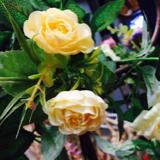


红叶朱蕉的养殖方法
温度
红叶朱蕉适宜温暖湿润的环境,阳光要充足,不能长期放置在阴暗的角落里面,由于是热带植物,室温要求保持在12摄氏度以上。
扦插
红叶朱蕉主要是通过扦插的方法来繁殖,最佳的扦插月份是七到九月,将红叶朱蕉的下半部分剪成七八厘米左右的小块,然后将其插在沙土中,浇少量水,使沙土湿润即可。在这种条件下,二十天左右就可以发芽了。
日照
夏季阳光比较强烈,要注意将红叶朱蕉搬至阴凉通风处,不能在阳光底下暴晒,否则很容易老化或者变暗。
在红叶朱蕉生长较快的季节里,要注意浇水和施肥。勤浇水,保持湿润,同时每两个星期施一次肥,以保证能够供给充足的养分给红叶朱蕉。在干燥天气,不要忘了向叶子上多洒一点水。冬季要将红叶朱蕉移到屋内光照充足处。在出现病虫害时,应该及时喷洒农药。


0
0
文章
权问薇
2017年07月23日


红叶朱蕉的养殖方法
温度
红叶朱蕉适宜温暖湿润的环境,阳光要充足,不能长期放置在阴暗的角落里面,由于是热带植物,室温要求保持在12摄氏度以上。
扦插
红叶朱蕉主要是通过扦插的方法来繁殖,最佳的扦插月份是七到九月,将红叶朱蕉的下半部分剪成七八厘米左右的小块,然后将其插在沙土中,浇少量水,使沙土湿润即可。在这种条件下,二十天左右就可以发芽了。

日照
夏季阳光比较强烈,要注意将红叶朱蕉搬至阴凉通风处,不能在阳光底下暴晒,否则很容易老化或者变暗。
在红叶朱蕉生长较快的季节里,要注意浇水和施肥。勤浇水,保持湿润,同时每两个星期施一次肥,以保证能够供给充足的养分给红叶朱蕉。在干燥天气,不要忘了向叶子上多洒一点水。冬季要将红叶朱蕉移到屋内光照充足处。在出现病虫害时,应该及时喷洒农药。

1
1
sarajordan2993
2017年07月22日

just took this picture of my #purslane (12:35am) - shes all closed up & sleeping . #succulent #weed
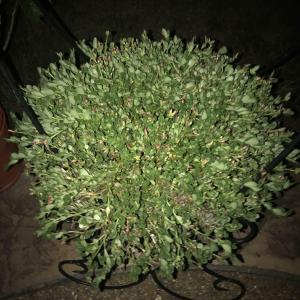
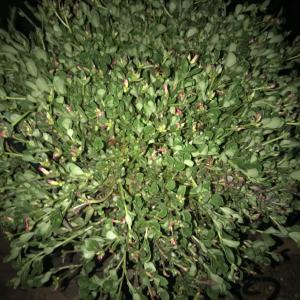


0
0
文章
Colour_
2017年07月17日


紫吊兰的养殖方法
(一)适宜的生长环境
吊兰生长适温为20~24℃,此时生长最快,也易抽生匍匐枝。30℃以上停止生长,叶片常常发黄干尖。冬季室温保持12℃以上,植株可正常生长,抽叶开花;若温度过低,则生长迟缓或休眠;低于5℃,则易发生寒害。
吊兰宜盆大株少,喜排水、透气性好的沙壤土,如中等大的花盆种2~3株为宜。株数过多,水分需要也多,如盆小土壤含水量供应不足,也易叶片枯萎。盆栽常用腐叶土或泥炭土、园土和河沙等量混合并加少量基肥作为基质。
吊兰喜温暖湿润的气候条件,不耐寒也不耐暑热,宜半阴,怕强光。适宜排水良好而又肥沃的沙质土壤,不耐寒。北方十月上旬,应将吊兰入室,挂在窗前或摆放在书架顶端,每五至七天用与室温相近的水喷洗枝叶一次。
(二)换盆
每两年的3月份换一次盆,换盆时,去掉部分陈土,稍修剪多余的根须,并剪除枯根和枯黄的叶子,重新调制培养土。换进由腐叶土三份和沙质土壤七份混合配制的培养土。盆底放2—3片碎骨片。生长期每隔10—14天施加一次稀
水培吊兰
薄肥液,肥料以氮肥为主。但金心和金边品种不宜施氮肥过量,否则叶片的线斑会变得不明显。施肥时要把叶片撩起。避免玷污叶片,容易伤害嫩叶和叶尖。每次施肥后最好用清水喷洒清洗叶面。
(三)浇水
吊兰喜湿润,其肉质根贮水组织发达,抗旱力较强,但3—9月生长旺期需水量较大,要经常浇水及向叶面喷雾,以增加湿度;秋后逐渐减少浇水量,以提高植株抗寒能力。夏天每天早晚应各浇水一次,春秋季每天浇水一次,冬季禁忌湿润,可每隔4—5天浇水一次,浇水量也不宜过多。吊兰适宜在空气湿润的环境下生长,如果空气干燥,则生长不良,叶子小而且尖端枯黄。因此,在生长旺盛时期应该每天向叶面喷水1—2次,以增加空气湿度。

紫吊兰的繁殖方法
吊兰可采用扦插、分株、播种等方法进行繁殖。
吊兰扦插和分株繁殖,从春季到秋季可随时进行。吊兰适应性强,成活率高,一般很容易繁殖。扦插时,只要取长有新芽的匍匐茎5-10厘米插入土中,约一个星期即可生根,20天左右可移栽上盆,浇透水放荫凉处养护。
吊兰分株时,可将吊兰植株从盆内托出,除去陈土和朽根,将老根切开,使分割开的植株上均留有三个茎,然后分别移栽培养。也可剪取吊兰匍匐茎上的簇生茎叶(实际上就是一棵新植株幼体,上有叶,下有气根),直接将其栽入花盆内培植即可。
吊兰的种子繁殖可于每年3月进行。因其种子颗粒不大,播下种子后上面的覆土不宜厚,一般0.5厘米即可。在气温15℃情况下,种子约2周可萌芽,待苗棵成形后移栽培养。带有叶艺的品种采用种子繁殖时,子代退化为全绿品种。
紫吊兰的病虫害防治
吊兰病虫害较少,主要有生理性病害,叶前端发黄,应加强肥水管理。经常检查,及时
抹除叶上的介壳虫、粉虱等等。吊兰不易发生病虫害,但如盆土积水且通风不良,除会导致烂根外,也可能会发生根腐病,可用多菌灵可湿性粉剂500-800倍液浇灌根部,每周一次,连用2-3次即可。
1
0




